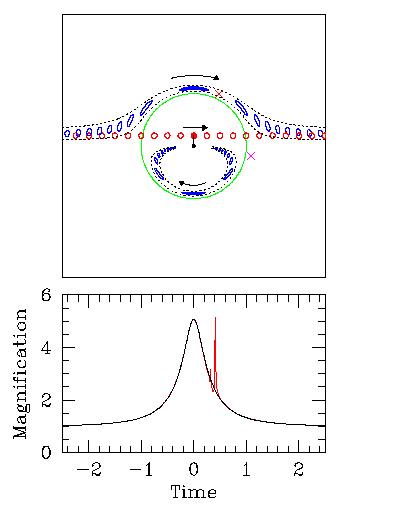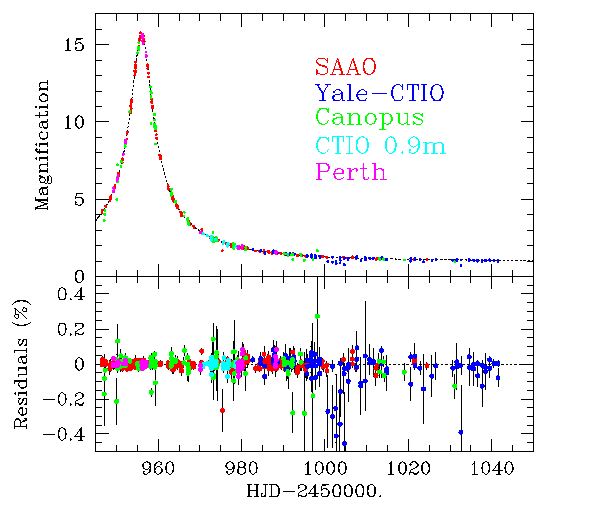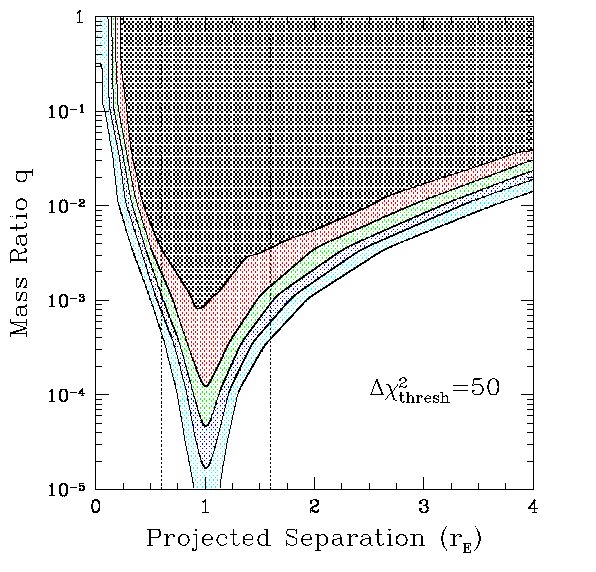
If the lens happens have a planet orbiting it, and the planet happens to lie in the path of one of the two images (for example, the red "X" in the top panel), then the planet will distort the image of the background source, creating a distortion to the normal single-lens curve. This can be seen as the red "spike" on the black single-lens light curve. This "spike" is a signature of a planet orbiting the primary lens.

In general, these "spikes" which are the signatures of planets are of very short duration. Therefore, these microlensing events must be monitored very closely in order to catch the deviations. The PLANET team monitors microlensing events alerted by the EROS, MACHO, and OGLE collaborations using four or five telescopes located throughout the southern hemisphere, with the goal of detecting these short-duration signatures of planets.
The microlensing event OGLE-1998-BUL-14 was first alerted by the OGLE collaboration as a possible high-magnification event toward the direction of the Galactic Bulge. The PLANET began monitoring this event soon after the alert, and followed the event intensively for approximately three months. The event reached a maximum magnification of ~16, and lasted approximately 40 days. The PLANET team light curve for OGLE-1998-BUL-14 is shown in the top panel below, with data from different PLANET observing sites coded in different colors. (Green = Canopus 1m in Tasmania; Red = SAAO 1m in South Africa; Blue = Yale-CTIO 1m in Chile; Cyan = CTIO 1m in Chile; Magenta = Perth 0.6m in Western Australia). The changing observed brightness of the background star is shown; each time mark represents five days on the horizontal scale.

The dotted line in the top panel shows the best-fit single-lens model. Note that the data points fall very close to the model, indicating that a single lens provides a good model for the data. The bottom panel shows the residuals in percent, i.e. the variation of the data about the model. The absence of any large deviations from the zero indicate that the data are consistent with an event caused by a single lens. In other words, there is no indication of any short duration "spike," as might be expected if the primary lens were orbited by a planet.
Microlensing is sensitive to two characteristics of a planetary system. These are the mass ratio between the primary lens star and the planet, and the instantaneous projected separation between the primary and the planet in units of the Einstein ring radius (see top figure). We can use the excellent coverage of the light curve of OGLE-1998-BUL-14, along with the high quality of the data, to place interesting constraints on the kinds of companions that might be present in the light curve of OGLE-1998-BUL-14, but below our ability to detect them. Do do this, we must calculate the detection efficiency of the OGLE-1998-BUL-14 to companions as a function of the mass ratio and projected separation.

In the figure above, we show contours of constant detection efficiency as a function of the mass ratio and projected separation for OGLE-1998-BUL-14. The shading represents efficiencies of >95% (black); 75-95% (red), 50-75% (green), 25-50% (blue) and 5-25% (cyan). All companions with mass ratios and separations in the black shaded region are excluded at the 95% confidence level, i.e. there is a less than 5% chance that the primary of OGLE-1998-BUL-14 has such a companion. Companions with mass greater than 1% of the primary are excluded for separations from 0.4 to 2.4 Einstein ring radii.
If we assume that the primary lens is a star with mass similar to our Sun and is at a distance of 6.5 kiloparsecs (80% of the distance between the Sun and the center of our galaxy), than we can put limits on companions in terms of the mass and physical separation of the companions. This is shown below.

This figure shows contours of constant detection efficiency as a function of the mass of the companion in Jupiter masses and the separation in Astronomical Units (where 1 AU is equal to the mean distance between the Earth and the Sun). Jupiter and Saturn are marked with stars, as are the extrasolar planets discovered with radial velocity techniques. We had a ~60% chance of detecting Jupiter in the light curve of OGLE-1998-BUL-14 and a ~5% chance of detecting Saturn. Click on the figure for a better view.
It is not possible to derive general inferences about the abundance and characteristics of binary or planetary systems from observations of any single system. Nevertheless, our results for OGLE-1998-BUL-14 clearly demonstrate the ability of microlensing to contribute to our knowledge of Jovian planets several AU from their parent stars, and -- if data of high enough quality can be collected for a large enough number of events -- to the search for and study of planets of much smaller mass as well. The analysis presented here for OGLE-1998-BUL-14 represents the first step in the larger task of performing a combined analysis of the growing PLANET data base of frequently and precisely monitored microlensing light curves. When completed, statistical inferences can be drawn about the frequency and distribution of stellar and Jovian companions to stellar lenses in the Galaxy.
To read the technical details concerning the analysis of OGLE-1998-BUL-14, download our preprint at astro-ph/9909325 or the published paper in the Astrophysical Journal (2000, 535, 176).